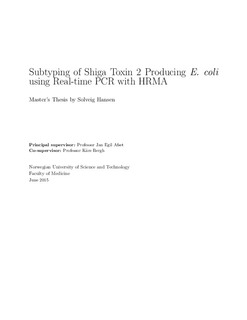| dc.description.abstract | Background: Shiga toxin producing E. coli (STEC) can produce two types of Shiga toxins (Stxs):
Stx1 and Stx2. The latter is more associated with severe disease such as haemolytic uremic syn-
drome (HUS) in humans, and is the main focus of this project. Stx2 can be categorised into several
subtypes which di er in virulence: Stx2a, Stx2b, Stx2c, Stx2d, Stx2e, Stx2g, and Stx2f, with Stx2a
and Stx2c being more virulent than other subtypes. Because of this it is desirable to be able to
di erentiate between them.
Aim: Two common methods used in Stx2 subtyping includes conventional PCR with agarose gel
electrophoresis and sequencing. As these methods are laborious and relatively expensive, the ob-
jective of this project was to nd a more e ective way of subtyping Stx2 producing E. coli.
Materials and Methods: Real-time PCR with high resolution melt analysis was chosen as a
method for Stx2 subtyping, and two di erent sets of primer pairs were tested and evaluated on
seven reference strains provided by Flemming Scheutz and Statens Serum Institut in addition to a
collection of pure and mixed culture samples containing Stx2 provided the Department of Medical
Microbiology at St. Olavs Hospital.
Results: The rst set of primer pairs could not successfully discriminate between the di erent
Stx2 subtypes. The second set showed more promise as it could di erentiate between subtypes
Stx2a, Stx2c, Stx2d, Stx2b, Stx2e, Stx2g, and determine that a sample contained Stx2a and Stx2c
or Stx2a and Stx2d when using the reference strains. Using the same set, 25 out of 29 pure culture
samples were successfully subtyped as well as 18 out of 21 mixed culture samples.
Discussion and Conclusion: There were some problems regarding primer e ciency, and some
of the tested patient samples were incorrectly subtyped or did not get ampli ed at all. Untill these
issues are resolved, the method should not be put into practice. | nb_NO |
